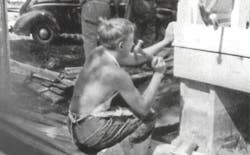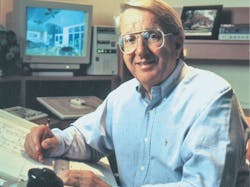I’d just returned from a long travel binge and was looking forward to a somewhat quiet day in the office, when the email came from an old friend. Bill Pulte had passed away. I was stunned.
I left Pulte Homes more than 20 years ago, and in the first five or so years following my departure, I saw Bill several times a year and we spoke numerous times on the phone. In the 15 years since, however, our contact had been sporadic. There was his retirement party, to which I felt honored to receive an invitation, and a few messages saying Bill had read and liked one of my columns or that my name had come up and he had asked to relay his regards. I confess that each of these made me puff up with pride like a kid receiving praise from his favorite teacher.
I only recently heard a hint that Bill was having health issues, but I never gave a thought to how I’d react to news of his death. I just sat in silence for about 10 minutes, eyes wet, my mind wandering over the decade I’d worked for him and the countless ways he’s influenced me since. Several times I opened my email to pass on the news to our TrueNorth staff and other former Pulte friends, but I just couldn’t write it out. I was surprised at how hard it hit me, then immediately regretted I hadn’t made a greater effort to stay in touch with Bill. I didn’t want to acknowledge that this story had an ending.
Call Me Bill!
My time with Bill began with a journey up Telegraph Road along Detroit’s western boundary on a cold, dreary November day in 1988. Thirty years have not dimmed the feelings of excitement and fear I felt in anticipation of the unknown. On one hand, it was just another interview. On the other, it was one that could change my career, personal life, and the life of my entire family. I had flown from my Chicago-area home that morning for an interview with Pulte Homes for what, as far as they knew, was the first position in the home building industry with the title of Vice President of Quality. I was intrigued.
I had always loved building, had a mishmash of experience in several trades, and had completely rebuilt two homes myself, but I’d never worked for an actual builder. Curiously though, that was part of the hiring profile. The Pulte company decidedly did not want anyone who had worked for years with a home building company. They wanted “new eyes”; someone who would refuse to accept “that’s just home building.” OK, check that box. But they did want someone with experience implementing quality systems in a variety of companies. Check and check. I turned off Telegraph, headed east on Long Lake Road, crossed over Woodward Avenue, and I’d arrived—not sure for what, exactly, but something told me providence was at work.
I had a long series of interviews that day with a bunch of what seemed to be great people, and over time that initial assessment proved correct. My last interview was with William J. Pulte, president and chairman of the board of what was then the largest home builder in America. The moment I was ushered into his office I heard for the first time what I was to hear a thousand times over the next decade: “Call me Bill! Please! Call me Bill,” which he implored everyone to do, regardless of title or status. That typically came with a big, welcoming smile and active, engaging eyes. Bill peppered me with questions about my background and was happy to know I could read a plan and knew the difference between a plate and a purlin, a joist and a J-channel, a king and a jack. But I emphasized that no, I had never been the employee of a home builder.
After my time at U.S. Steel in production, and managing quality systems at Motorola, I had split between two national consulting firms and worked with a wide assortment of big-name companies. Yet never once had either of the consulting firms worked with a home builder. In one of those serendipitous life events, Bill and I immediately hit it off, finding common ground on issues such as how quality must be based on prevention, not inspection. Our discussion explored many avenues until I finally asked my key question: “Why does Pulte need a VP of Quality?” He stopped and thought for a while, then launched into the now well-known story of how he began building as an 18-year-old with a $5 plan bought from The Detroit News and a couple of thousand dollars borrowed from his grandmother. His journey was a genuine Horatio Alger tale of nice, hardworking boy with a vision makes good in America. I had read about these legendary people, men such as Andrew Carnegie, Henry Ford, and Harvey Firestone, but I had never met one—until now. I was in awe.
What Were They Thinking?
During my interview, Bill covered the decades of the ’50s and ’60s and how he built churches and schools as well as houses. Many have heard him describe how he sat on the roof of his very first house and realized he needed to hire others for the labor while he’d buy the land, design the homes, and manage the process.
Then, in one of the most audacious dreams ever conjured by an 18-year-old, Bill said to himself, “I want to be on the New York Stock Exchange,” and “I want to be the biggest builder in America.” Some years later, he began hiring bright financial, operating, and marketing folks who helped Pulte Homes aggressively spread across the nation. At the time of our interview, the firm had 16 divisions.
Bill walked me through the ’70s and ’80s, then abruptly stopped, lost in thought. I knew something significant was coming. “You know,” he said, “If you bought a Pulte Home in the ’50s and ’60s, it was a great home when you bought it, and it’s still a great home today. But in our big growth years of the ’70s and ’80s, we built a lot of liabilities.” He punctuated that with what I’d soon learn was his favorite phrase: “You follow me?”
Not sure that I did, we sat in silence for a moment. I think we were both surprised at how open and honest he had been. Bill went on to describe how during Pulte’s growth, many operations had strayed from the essential principles upon which he’d built the company. He cited multiple examples, all of which he ended with another of his favorite phases: “What were they thinking?” Then Bill leaned forward, pointed at me, and said, “We need a guy like you to help us fix that … You follow me?”
More than a bit overwhelmed, I did my best to stay cool and professional. I was just past my 36th birthday and Bill Pulte, chairman of the board of this mammoth builder, said he needed, uh, me. Was I ready for that much responsibility? Honestly, no. But something special happened that day. I fell in love—with Bill Pulte, a company full of both promise and problems, and Bill’s belief that I could make a difference.
I finished up with Pulte’s head of HR and drove back down a rain-slick Telegraph Road, almost giddy because, even though there were more candidates to interview, I was confident I’d get the job. I was simultaneously excited and scared as hell. And it was this overwhelming feeling that came back to me after I learned of Bill’s passing.
It was simple, dumb luck that when I transferred from an initial assignment in Pulte’s Chicago office to Detroit headquarters, the only open office was just one door down from Bill Pulte’s. Being so close to Bill was a stroke of good fortune. I soon learned that each time I saw Bill walk by with a plan, a golden opportunity presented itself. He had a huge table in his office where he would lay out those plans and begin tinkering with them. As he did, he liked having someone around he could talk to about what he found. I can’t fathom how many times I heard, “You follow me?” as he pointed out something on the plan or made a red line. And when he found something he didn’t like, “What were they thinking?” was the usual refrain. These plans came in from every division; thus I was tutored by the master on what works, and what doesn’t, all across America.
Nice Day for a Walk
Even better than reviewing plans in Bill’s office was walking them with him in the field. There are literally thousands of home building pros out there today upon whom those walks had a profound impact. I estimate I was on at least 30 of those walks with Bill, and they could be day-long affairs reviewing 12 or 15 homes across multiple sites.
I well remember my first one out West. When Bill came to town, the local division always assembled a substantial entourage, with Bill as the pied piper, leading the throng down a street in a community. Bill admonished us to say “community,” never “subdivision.” We had not walked 100 feet when he casually reached down, picked up a candy wrapper, and stuffed it in his pocket. Everyone noticed, quizzical looks all around. Maybe another 100 feet down the road—all the while holding forth to the troops in his “mobile workshop”—Bill picked up a smashed-flat Coke can and again, put it in his pocket. Now, after the candy wrapper, no one was sure how to respond, but when Bill added the Coke can to his pocket, the 10 or 12 others on the walk, including the division president, all began picking up trash, too. It became competitive, everyone looking for trash.
After the fact, it was amusing, and people in that division retold the story over and over again. They later heard from a crew leader, sitting in his truck across from that dumpster waiting for the rest of his guys to arrive. He said it was the damnedest thing; here comes this white-haired fella with a gang of guys in tow, all emptying their trash-filled pockets into the dumpster. He joked that he felt he should jump out and find some trash, too, but the streets had pretty well been picked clean!
The field walks were amazing events, chock full of advice from Bill on everything from efficient framing to the nuances of elevations to how customers perceive the product. We built affordable, attainable homes, and understanding what customers will pay for and what they will not was a critical distinction. From 100 feet, Bill could instantly call out a column that was too large or too small or not quite right in its placement. He could pick out a tiny aberration in a roof pitch. It is claimed that some people can “see in 3-D,” but Bill was the best I’ve ever known.
One time we were walking by a house framed up but without any mechanicals, insulation, wall board, or siding—just sticks. It wasn’t an official stop on the tour that day, but Bill paused, pointed, and said, “That kitchen window is framed for a 3-0. It needs to be at least a 3-2, maybe 3-4. Check that out,” and on we walked. Yes, there is a punch line: That window was on the back wall of the house, and we were walking down the road in front. Bill made that call looking through the four other framed walls. As he walked on, the rest of us were left shaking our heads in disbelief. But we knew we’d find that Bill was right.
Passing It On
These walks were wonderful, educational, and enlightening experiences for most, but not all. Bill Pulte was a kind, sensitive man. He would go out of his way to help anyone who came forward with the right attitude and wanted to learn from a mistake. But the idiom, “does not suffer fools gladly,” absolutely applied to Bill. On one walk, he asked repeated questions of the construction VP about the cost of certain items—this lam beam, that countertop, this type of flooring, that window. The VP didn’t know. Neither did he know the cost of siding, of different concrete mixes, or the landscaping package. You could see Bill’s temperature rising. The final straw was the VP’s ignorance of the cost of the in-ground pool they chose to install behind one of the models. By the next week, that VP was no longer a member of the team. Bill Pulte simply would not abide a senior staff member not knowing the costs at his own project.
Only a day or two prior to Bill’s death, I read an obituary of a pioneering surgeon and wondered just how much of all his incredible knowledge went with him to the grave. Then I read how this esteemed doctor had served on the staff of a great teaching hospital for more than 30 years, always a favorite of residents and fellows. He spent his entire career not just practicing his skills and collecting considerable rewards, but helping other surgeons learn what he knew. He had stated, in fact, that teaching and developing young doctors was his greatest reward. It seems this great surgeon’s knowledge didn’t die with him after all.
And so it was with Bill Pulte. He absolutely delighted in sharing his knowledge and helping people grow, whether it was with his home building colleagues, his grandchildren, or the countless people he helped through his largely anonymous charitable work. That old saying, “When the student is ready, the teacher will come,” perfectly describes me on that November day three decades ago, and so it has been for hundreds, probably thousands of others as well. At the point they were ready to learn, Bill was there for them and thus ensured that his knowledge would pass on to the next generation and beyond.
In my next column, I’ll lay out my painfully condensed list of specific things I learned from Bill Pulte. Painfully condensed because it could literally be a book-length article.
About the Author

Scott Sedam
Scott Sedam is president of TrueNorth Development, a consulting and training firm that works with builders to improve products, process, and profits. A senior contributing editor to Pro Builder, Scott writes about all aspects of the home building business and won the 2015 Jesse H. Neal Award, business journalism's most prestigious prize, for his commentary in Pro Builder. Scott invites you to join TrueNorth's Lean Building Group on LinkedIn and welcomes your feedback at [email protected] or 248.446.1275.


